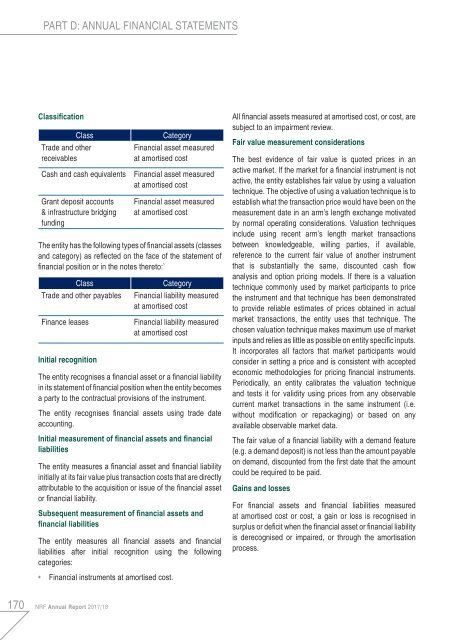NRF Annual Report 2018
You also want an ePaper? Increase the reach of your titles
YUMPU automatically turns print PDFs into web optimized ePapers that Google loves.
PART D: ANNUAL FINANCIAL STATEMENTS<br />
Classification<br />
Class<br />
Trade and other<br />
receivables<br />
Cash and cash equivalents<br />
Grant deposit accounts<br />
& infrastructure bridging<br />
funding<br />
Category<br />
Financial asset measured<br />
at amortised cost<br />
Financial asset measured<br />
at amortised cost<br />
Financial asset measured<br />
at amortised cost<br />
The entity has the following types of financial assets (classes<br />
and category) as reflected on the face of the statement of<br />
financial position or in the notes thereto:`<br />
Class<br />
Trade and other payables<br />
Finance leases<br />
Initial recognition<br />
Category<br />
Financial liability measured<br />
at amortised cost<br />
Financial liability measured<br />
at amortised cost<br />
The entity recognises a financial asset or a financial liability<br />
in its statement of financial position when the entity becomes<br />
a party to the contractual provisions of the instrument.<br />
The entity recognises financial assets using trade date<br />
accounting.<br />
Initial measurement of financial assets and financial<br />
liabilities<br />
The entity measures a financial asset and financial liability<br />
initially at its fair value plus transaction costs that are directly<br />
attributable to the acquisition or issue of the financial asset<br />
or financial liability.<br />
Subsequent measurement of financial assets and<br />
financial liabilities<br />
The entity measures all financial assets and financial<br />
liabilities after initial recognition using the following<br />
categories:<br />
All financial assets measured at amortised cost, or cost, are<br />
subject to an impairment review.<br />
Fair value measurement considerations<br />
The best evidence of fair value is quoted prices in an<br />
active market. If the market for a financial instrument is not<br />
active, the entity establishes fair value by using a valuation<br />
technique. The objective of using a valuation technique is to<br />
establish what the transaction price would have been on the<br />
measurement date in an arm’s length exchange motivated<br />
by normal operating considerations. Valuation techniques<br />
include using recent arm’s length market transactions<br />
between knowledgeable, willing parties, if available,<br />
reference to the current fair value of another instrument<br />
that is substantially the same, discounted cash flow<br />
analysis and option pricing models. If there is a valuation<br />
technique commonly used by market participants to price<br />
the instrument and that technique has been demonstrated<br />
to provide reliable estimates of prices obtained in actual<br />
market transactions, the entity uses that technique. The<br />
chosen valuation technique makes maximum use of market<br />
inputs and relies as little as possible on entity specific inputs.<br />
It incorporates all factors that market participants would<br />
consider in setting a price and is consistent with accepted<br />
economic methodologies for pricing financial instruments.<br />
Periodically, an entity calibrates the valuation technique<br />
and tests it for validity using prices from any observable<br />
current market transactions in the same instrument (i.e.<br />
without modification or repackaging) or based on any<br />
available observable market data.<br />
The fair value of a financial liability with a demand feature<br />
(e.g. a demand deposit) is not less than the amount payable<br />
on demand, discounted from the first date that the amount<br />
could be required to be paid.<br />
Gains and losses<br />
For financial assets and financial liabilities measured<br />
at amortised cost or cost, a gain or loss is recognised in<br />
surplus or deficit when the financial asset or financial liability<br />
is derecognised or impaired, or through the amortisation<br />
process.<br />
• Financial instruments at amortised cost.<br />
170<br />
<strong>NRF</strong> <strong>Annual</strong> <strong>Report</strong> 2017/18


